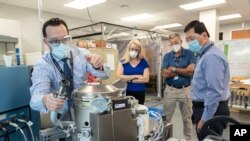A flight carrying NASA's new $23 million titanium space toilet, designed as a better fit for female astronauts, failed to launch late Thursday and has another window Friday night.
NASA tweeted late Thursday the launch was canceled about 2 minutes before liftoff "due to an unknown problem with a component of ground support equipment."
Northrop Grumman, maker of the Antares rocket, said a Friday night launch from Wallops Island, Virigina, would be attempted, if engineers can solve the issue.
Among the cargo heading to the International Space Station is a new toilet that is better designed for female astronauts to go No. 2, a NASA official said.
The toilets currently on the ISS cater more toward men. But with more women joining the ranks, NASA set out to make a better toilet, tilting the seat and making it taller, said Melissa McKinley, the project manager at the Johnson Space Center.
"Cleaning up a mess is a big deal. We don't want any misses or escapes," McKinley said.
Also, the funnels have been redesigned so women can use the elongated and scooped-out funnels to urinate while sitting on the commode to defecate at the same time, McKinley said. Until now, it's been one or the other for female astronauts, she noted.
At barely 100 pounds and 28 inches tall, the new toilet is approximately half as big as the two Russian-built ones at the space station. Its small size makes it a perfect fit for the NASA Orion capsules that will carry astronauts to the moon in a few years.
The new toilet is to be used alongside the old one on the U.S. side of the ISS.
Like earlier space commodes, air suction, rather than water and gravity, removes the waste. Urine collected by the new toilet will be routed into NASA's long-standing recycling system to produce water for drinking and cooking. Titanium and other tough alloys were chosen for the new toilet to withstand all the acid in the urine pretreatment.
More toilets will be needed as SpaceX launches astronauts to the space station and Boeing stays on course to send up its first crew in less than a year.
The typical space station population will go from six to seven with the next SpaceX flight, and even more when nonprofessionals like tourists start showing up as early as next year.
The last time NASA ordered up a new toilet was in the early 1990s to accommodate a two-week space shuttle mission.









